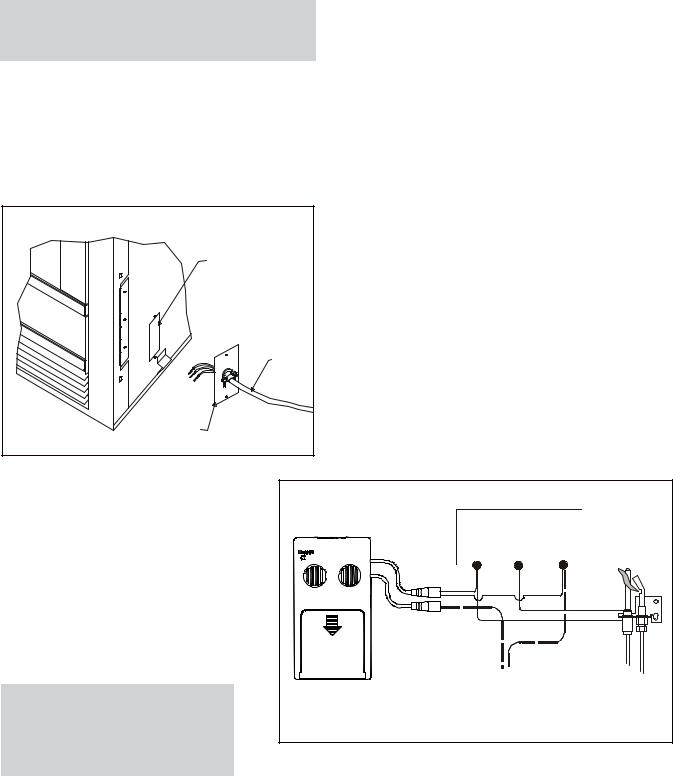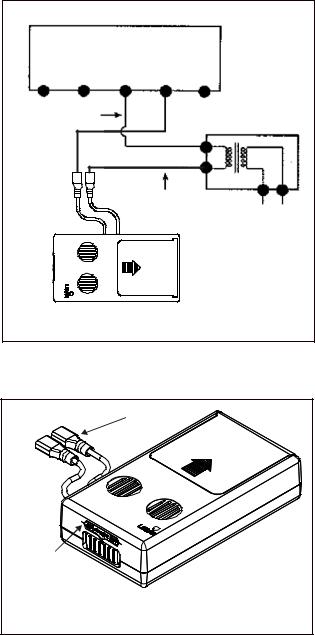Hearth and Home Technologies SMART-STAT-II User Manual

SMART-STAT-II Remote Control Kits |
|
|
- Installation and Operating Instructions - |
|
|
|
|
INTRODUCTION |
FCC REQUIREMENTS |
The remote control system can be operated thermostatically or manually from the transmitter. The system operates on radio frequencies (RF) within a 20 foot range. Can be used with DSI, IPI or Standing Pilot systems.
This remote control kit has a hand held transmitter that can be used as a remote on/off or as a thermostat. The transmitter display shows the current room temperature, target temperature, timer setting, on/off status, low battery indicator, current time and burner/valve operation. Electrical ratings for the receiver are: 110 VAC, 60 Hz.
If pertinent, see additional fireplace wiring diagrams on pages 8 to 10.
INSTALLATION PRECAUTIONS
This remote control kit is tested and safe when installed in accordance with this installation manual. Installation of this kit MUST be done by a qualified service technician. It is the responsibility of the installer to read all instructions before starting installation and to follow these instructions carefully during installation. Modification of the remote control system or any of its components will void the warranty and may cause a fire hazard.
NOTE: The factory installed junction box in the gas fireplace must be wired with 110 VAC before installing this kit. See Installation Instructions section.
CAUTION: All wiring should be done by a qualified electrician and shall be in compliance with local codes and with the National Electric Code ANSI/NFPA No. 70-current (in the United States), or with the current CSA C22.1 Canadian Electric Code (in Canada).
WARNING: DO NOT CONNECT 110-120 VAC WIRING TO THE GAS CONTROL VALVE OF THIS APPLIANCE.
WARNING: CHANGES OR MODIFICATIONS TO THIS UNIT NOT EXPRESSLY APPROVED BY THE PARTY RESPONSIBLE FOR COMPLIANCE COULD VOID THE USER'S AUTHORITY TO OPERATE THE EQUIPMENT.
NOTE: This equipment has been tested and found to comply with the limits for a Class B digital device, pursuant to Part 15 of the FCC Rules. These limits are designed to provide reasonable protection against harmful interference in a residential installation. This equipment generates, uses, and can radiate radio frequency energy and, if not installed and used in accordance with the instructions, may cause harmful interference to radio communications. However, there is no guarantee that interference will not occur in a particular installation.
Canadian Equipment Requirements
This digital apparatus does not exceed the (Class A/ Class B)* limits for radio noise emissions from digital apparatus set out in the Radio Interference Regulations of the Canadian Department of Communications. Le present appareil numerique n'emet pas de bruits radioelectriques depassant les limites applicables aux appareils numeriques (de la class A/de la class B)* prescrites dans le Reglement sur le brouillage radioelectrique edicte par le ministere des Communications du Canada.
This device complies with RSS-210 of Industry and Science Canada. Operation is subject to the following two conditions: (1) this device may not cause interference, and (2) this device must accept any interference, including interference that may cause undesired operation of the device.
Hearth & Home Technologies Inc.
20802 Kensington Boulevard, Lakeville, MN 55044
100-906F 12/06
1

INSTALLATION INSTRUCTIONS
Installing Electrical Service to the Junction Box
WARNING: TURN ELECTRICAL POWER OFF AT THE CIRCUIT BREAKER BEFORE BEGINNING THIS INSTALLATION.
NOTE: Some appliances do not have a cover plate. Instead, there is a hole through which the Romex clamp is attached to the outer wrap.
1.Remove the electrical cover plate from the lower side of the fireplace. Remove the knock-out from the plate and attach the Romex clamp (screws to the outside) (see Figure 1).
|
ACCESS HOLE |
|
110 VAC |
|
SERVICE |
|
COVER |
Figure 1 |
PLATE |
|
REMOTE RECEIVER
Important: The remote receiver should be positioned close to front in right or left corner.
The remote receiver is powered by 110-120VAC. It plugs into a standard polarized duplex receptacle.
Locating Receiver and Operating Functions
This remote receiver can be positioned under the firebox in the control compartment of the fireplace if ambient temperatures do not exceed 1700 F. This system is designed to remotely operate the gas valve.
RECEIVER WIRING INSTRUCTIONS
Incorrect wiring connections WILL cause damage to the gas valve or electronic module operating the gas appliance and may also damage the remote receiver.
Wiring Millivolt Valves
Connect the remote receiver by connecting each of the two wires leading from the remote receiver to either of the two wire TH terminals on the gas valve (see Figure 2). Normally it does not matter which wires go to which terminal.
2.Feed the electrical service wires through the Romex clamp and secure the wires to the clamp.
3.Using the wire nuts provided, connect the service wires to the junction box. The black wires to the black service wire, the white wires to the white service wire, and the service ground wire to the ground stud of the junction box.
4.Re-attach the cover plate to the outside of the fireplace.
WARNING: LEAVE ELECTRICAL POWER OFF AT THIS TIME. DO NOT RESTORE POWER UNTIL THE REMOTE CONTROL SYSTEM IS COMPLETELY INSTALLED.
|
TERMINAL BLOCK |
|
ON MILLIVOLT GAS VALVES |
||
TH |
TP |
TH |
TP |
||
REMOTE |
WALL |
THERMOPILE/ |
SWITCH |
PILOT LIGHT |
|
RECEIVER |
|
|
Figure 2. Wiring Millivolt Valves |
|
|
Alternative Wiring for units with a wall switch
Disconnect the wall switch wire from the TH terminal on the valve and connect this wire to male connector supplied on the receiver. Connect remaining female connector from receiver to the TH terminal on the valve.
2

Wiring Electronic Spark Ignitions
The remote control receiver can be wired, in series, to a 24VAC transformer, which controls an electronic ignition module (see Figure 3).
1.Connect the neutral wire from the 24VAC transformer to the TR (transformer) terminal on the Electronic Module.
2.Connect the hot wire from the 24VAC transformer to either of the wires from the remote receiver.
3.Connect the other wire from the receiver to the TH (thermostat) terminal on the Electronic Module.
ELECTRONIC MODULE
TR |
TH |
NEUTRAL |
110/24VAC |
WIRE |
TRANSFORMER |
|
24VAC |
|
HOT WIRE |
|
120VAC |
|
REMOTE |
|
RECEIVER |
Figure 3. Wiring Electronic Spark Ignitions
The remote receiver has a 3-position slide switch: OFF/ REMOTE/ON (see Figure 4).
WIRE |
TERMINALS |
ON/OFF |
REMOTE SLIDE SWITCH |
Figure 4. Remote Receiver |
NOTE: The remote receiver will only respond to the transmitter when the 3-position slide button on the remote receiver is in the Remote position. If the system does not respond to the transmitter on initial use, see section Matching Security Codes.
1.With the slide switch in the ON position, the system is on.
2.With the slide switch in the REMOTE position, the system only operates if the remote receiver receives commands from the transmitter.
3.With the slide switch in the OFF position, the system is off.
NOTE: The slide switch should be placed in the OFF position if you will be away from your home for an extended period of time. Placing the switch in the OFF position also functions as a safety “lock out” by turning the system off and rendering the remote receiver inoperative.
TRANSMITTER
Important: Before operating remote control, transmitter and receiver must have matching security codes. See section ‘Matching Security Codes’.
Important: Review ‘Communication-Safety Features’ under ‘Transmitter Safety Features’ section. The communication safety features shut down the fireplace system when a potentially unsafe condition exists.
Important: Review ‘Auto Shutdown’ section. This safety feature shuts down the fireplace after 9 hours of continuous operation, in ON mode only.
Important: New or fully charged batteries are essential for proper operation of the multi-function transmitter. The transmitter operates on 2 AAA-size 1.5V batteries. Use Alkaline batteries for longer battery life and maximum operational performance.
Insert 2 AAA-size 1.5V batteries into the battery compartment on the back of the transmitter. When the batteries are correctly inserted, the screen will display numbers (see Figure 5 for LCD Display Screen).
NOTE: If the transmitter is activated from a very cold condition it may be necessary to allow the transmitter to stabilize to room temperature (could take up to 15 minutes) before accurate room temperatures are displayed on the screen.
NOTE: LCD screen is equipped with a “backlite” for easier viewing of LCD screen. Backlite illuminates when a function button is depressed. After 5 seconds elapses, LCD screen will return to its normal state.
3
